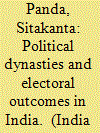|
|
|
Sort Order |
|
|
|
Items / Page
|
|
|
|
|
|
|
| Srl | Item |
| 1 |
ID:
188240


|
|
|
|
|
| Summary/Abstract |
Political dynasties, a salient feature of the electoral politics in many electoral democracies, have critical governance implications. However, careful empirical estimates of the dynasty premium in Indian elections and explanation of their constituency-level demand side (voters) and supply side (political parties) determinants are absent. To fill this gap, we analyze the candidate-level (N = 8251) data on the 2014 Lok Sabha elections and find that a dynastic candidate is a significant 13% more likely to win and has a significant 18%–20% higher vote share than a non-dynastic candidate. This result is robust to consideration of an alternative dynasty variable as outcome, usage of alternative indicators of candidate criminality as controls, and a procedure of deducing bias due to selection on unobservables from selection on observables. In the constituency-level analyses, having a dynastic incumbent legislator in fray and dynasts’ relative wealth increases the probability of a dynastic winner and a more competitive election given the dynastic incumbent reduces it. Voter dissatisfaction, dynasts’ relative wealth, reserved constituency, and given a dynastic incumbent, higher political competition reduce voter preference for dynasts, whereas dynastic entrenchment and dynastic incumbent reduce it. The dynastic incumbent, dynasts’ relative wealth, and voter dissatisfaction significantly increase political parties’ preferences for dynasts.
|
|
|
|
|
|
|
|
|
|
|
|
|
|
|
|
| 2 |
ID:
165090


|
|
|
|
|
| Summary/Abstract |
Elections bestow popular legitimacy to the democracies and, accordingly, electoral participation is an important indicator of the quality of democracy and civic engagement. Understanding what factors drive citizens’ decision to vote is central to the theory and practice of democracy and has implications for voter mobilization efforts of political parties and government agencies. We study the individual level determinants of electoral turnout in the 2004 Lok Sabha elections exploiting a nationally representative India Human Development Survey-2005 (IHDS-2005). We find convincing yet mixed evidence in support of political-institutional factors, and some variables of the psychological, mobilization, socialization, and resource models in explaining voter turnout. Public confidence in state government, newspapers, and judiciary, television watching, participation in civic body meetings, local conflict, caste conflict in neighborhood, local political connections, and caste association membership significantly increase the predicted probability of turnout. Factors like time family lived in the place, age, holding of below-poverty-line (BPL) cards, and receipt of public benefits increase voter turnout; whereas, business association membership, being female, metro-city resident, business being the main income source, urban residence, and the age quadratic reduce voter turnout. Separate analyses of the rural and urban, male and female contexts largely obtain the same line of results.
|
|
|
|
|
|
|
|
|
|
|
|
|
|
|
|
|
|
|
|
|